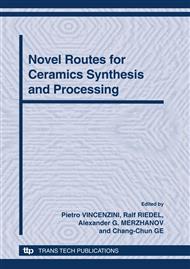[1]
A.G. Merzhanov, I.P. Borovinskaya, Dokl. Chem. Vol. 204 (2) (1972) p.429.
Google Scholar
[2]
A.G. Merzhanov, J. Mat. Chem. Vol. 14 (12) (2004) p.1779.
Google Scholar
[3]
P. Roth, Proceed. Combust. Inst., Vol. 31(2) (2007), p.1773.
Google Scholar
[4]
A. G. Merzhanov, I. P. Borovinskaya, A. E. Sytchev, in Lessons in nanotechnology from traditional materials to advanced ceramics ed. by Baumard J.F., (Techna Group Srl. 2005), p.1.
Google Scholar
[5]
A.S. Mukasyan, K.S. Martirosyan ed., Combustion of heterogeneous systems: fundamentals and applications for material synthesis, (Trans Res Network, India 2007).
Google Scholar
[6]
S. T. Aruna, A. S. Mukasyan, Current Op. in Sol. State. Mater. Sci. vol. 12 (2008) p.44.
Google Scholar
[7]
J.J. Kingsley JJ, K.C. Patil, Mater Lett Vol. 6 (1988) p.427.
Google Scholar
[8]
K.C. Patil, M.S. Hegde, Tanu Rattan, S.T. Aruna, Chemistry of nanocrystalline oxide materials: combustion synthesis, properties and applications, (World Scientific, Singapore 2008).
DOI: 10.1142/6754
Google Scholar
[9]
A.S. Mukasyan, P. Epstein, P. Dinka, Proc. Combust. Inst. Vol. 31(2) (2007) p.1789.
Google Scholar
[10]
A.S. Mukasyan, P. Dinka, International Journal of Self-Propagating High-Temperature Synthesis, Vol. 16 (1) (2007) p.23.
Google Scholar
[11]
P. Dinka, A. S. Mukasyan, J. Phys. Chem., Vol. 109 (2005) p.21627.
Google Scholar
[12]
A. S. Mukasyan and P. Dinka, Adv. Eng. Mat., Vol. 9 (2007) p.653.
Google Scholar
[13]
A. S. Mukasyan, P. Dinka, US-patent: WO2007019332-A1.
Google Scholar
[14]
K.S. Patil, S.T., Aruna, S. Ekambaram, Curr. Opin. Sol. State Mater. Sci., Vol. 2 (1997) p.158.
Google Scholar
[15]
K.S. Patil, S.T. Aruna, S., T. Mimani, Curr. Opin. Sol. State Mater. Sci. vol 6 (2003) p.507.
Google Scholar
[16]
R. E. Muenchausen, E.A. McKigney, L.G. Jacobsohn, M.W. Blair B.L. Bennett BL, D.E. Cooke DW. IEEE Trans Nucle Sci, Vol. 55, (2008) p.1532.
DOI: 10.1109/tns.2008.922844
Google Scholar
[17]
H. Song, D. Chen. Lumin Vol. 22 (2007) p.554.
Google Scholar
[18]
S. Qiu, Y. Zhou, M. Lu M, A. Zhang, Q. Ma, Solid State Sci Vol. 10 (2008) p.629.
Google Scholar
[19]
Y. Jin, W.P. Qin, J.S. Zhang, Y. Wang, C.Y. Cao, J Solid State Chem, Vol. 181 (2008) p.724.
Google Scholar
[20]
X.M. Lou, D.H. Chen, Mater Lett Vol. 62 (2008) p.1681.
Google Scholar
[21]
Z. Qiu, Y. Zhou, M. Lu, A. Zhang, Q. Ma, Acta Mater Vol. 55 (2007) p.2615.
Google Scholar
[22]
R. Krsmanovi´c, V.A. Morozov, O.I. Lebedev, S. Polizzi, A. Speghini, M. Bettinelli, G. Van Tendeloo, Nanotech Vol. 18 (2007) p.325604.
DOI: 10.1088/0957-4484/18/32/325604
Google Scholar
[23]
L. Xu, B. Wei, Z. Zhang, Z. Lü, H. Gao,Y. Zhang, Nanotech Vol. 17 (2006) p.4327.
Google Scholar
[24]
X.L. Xu, J.D. Guo, Y.Z. Wang, Y.Z., Nanoparticles, Mater. Sci. Eng. B, Vol. 77 (2000) p.207.
Google Scholar
[25]
K. Deshpande, A.S. Mukasyan, A. Varma, Chem Mater., Vol. 16(24) (2004) p.4896.
Google Scholar
[26]
G. Sivalingam, M.H. Priya, G. Madras, G., Appl. Catal. B, 2004, Vol. 51 (1) (2004) p.67.
Google Scholar
[27]
M. Muthuraman, A.A. Dhas, K.C. Patil, K., Bull. Mater. Sci., Vol . 17(6) (1994) p.977.
Google Scholar
[28]
M. Muthuraman, K.C. Patil, Mater. Res. Bull., Vol. 33 (4) (1998) p.655.
Google Scholar
[29]
A. D. Lan, A., A.S. Mukasyan, J. Phys. Chem, Vol. 26, (2007) p.9573.
Google Scholar
[30]
A. D. Lan , A.S. Mukasyan, Ind. & Eng. Chem. Res. Vol. 47(23) (2008) p.8989.
Google Scholar
[31]
C. Agrafiotis, M. Roeb, A. Konstandopoulos, L. Nalbandian, et al., Solar Energy Vol. 79 (2005) p.409.
Google Scholar
[32]
S. Schuyten, P. Dinka, A.S. Mukasyan, E. Wolf E. Catal Lett Vol. 121 (2008) p.189.
Google Scholar
[33]
A. Kumar, A. S Mukasyan, E. E. Wolf, Applied Catalysis A: General, Vol. 372 (2010) p.175.
Google Scholar
[34]
S. Sharma S, M.S. Hegde , Catal Lett Vol. 112 (2006) p.69.
Google Scholar
[35]
N. Russo, D. Mescia, D. Fino, G. Saracco, V. Specchia, Ind Eng Chem Res, Vol. 46 (2007) p.4226.
DOI: 10.1021/ie0612008
Google Scholar
[36]
P. Dinka, A.S. Mukasyan, J. Power Sources, Vol. 167 (2007) p.472.
Google Scholar
[37]
J. Choong-Hwan , L. Hee-Gyoun, K Chan-Joong, B.B. Bhaduri, Journal of nanoparticle research Vol. 5 (2003) p.383.
Google Scholar
[38]
J. Choong-Hwan, S. Jalota, B.B. Bhaduri SB. Materials letter, Vol. 59 (2005) p.2426.
Google Scholar
[39]
A. Kumar, E.E. Wolf, A.S. Mukasyan J. AIChE (2010), in press.
Google Scholar


